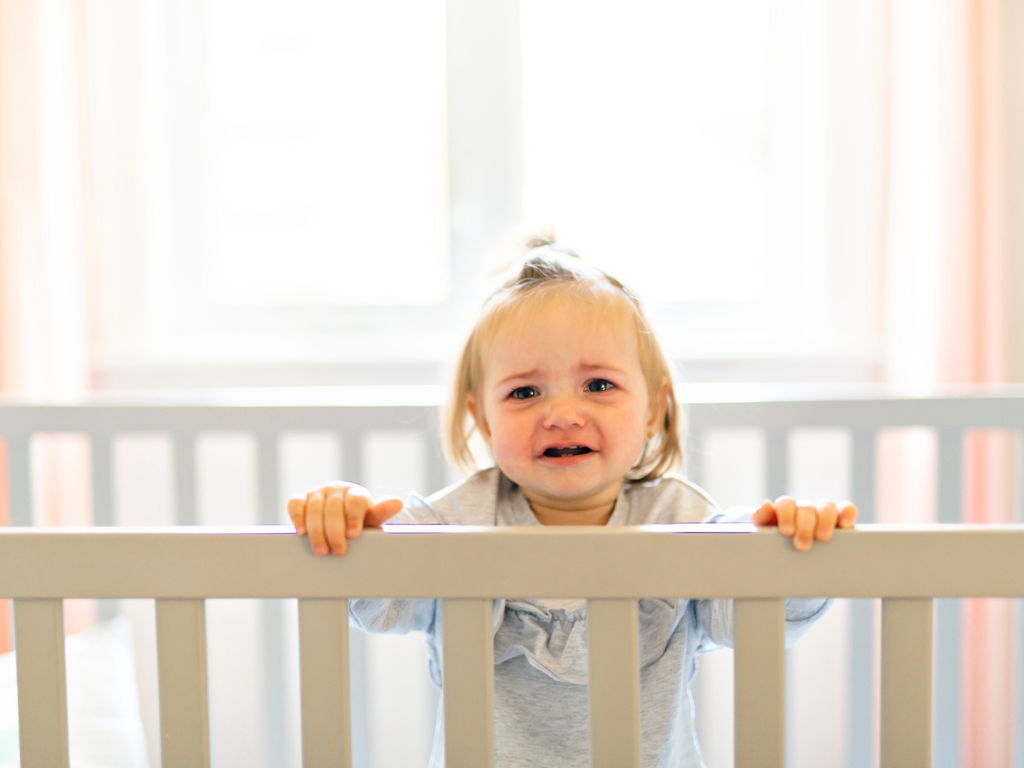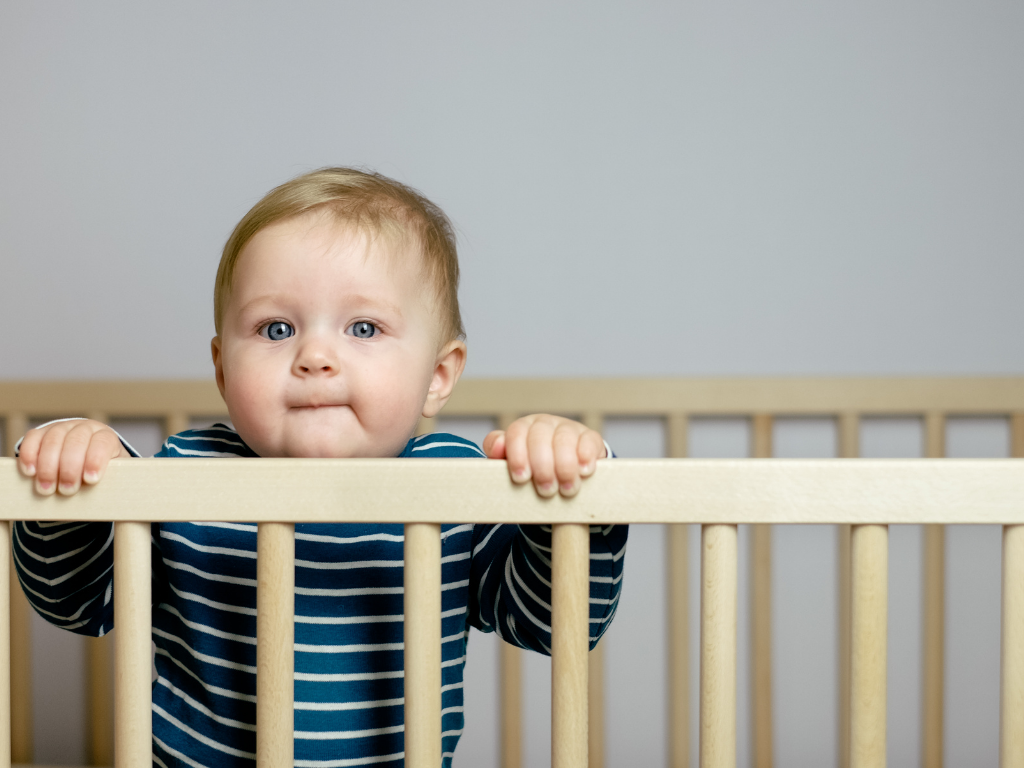Sleep training research: unpacking sleep training culture
We live in a sleep training culture.
Its effects on parenting around sleep are powerful, and parents feel that pressure. When you dig into the research on sleep training, however, you find that it isn’t as soundly supported as many parents and professionals believe. In this post, I’m highlighting 10 facts about sleep training research that everyone should know to make informed decisions about how you support sleep for your children.
This critique of sleep training research comes from my own research and knowledge as well as being influenced by the work of Tracey Cassels, PHD; Lyndsey Hookway, IBCLC, Holistic Sleep Coach; and Macall Gordon, MA. Their talks and writing on this subject are wonderful, and their knowledge of statistics far exceeds mine.
Background on sleeping training methods
The most commonly researched sleep training strategy is extinction and graduated extinction. This includes cry it out, controlled crying, Ferber, timed checks, some forms of camping out, and variations. While other strategies are researched, extinction methods do seem to be the favorite in research and popular advice. Most of the popular sleep training programs have some sort of controlled crying at their heart, and 60% of popular baby parenting books promote cry it out or controlled crying according to one study (Ramos and Youngclark, 2006).
The belief that sleep training is the only way to manage infant sleep is so strong that parents often don’t know that they can choose not to sleep train or that there are other ways to try to improve sleep. Parents feel this pressure from family, friends, and pediatricians and other health professionals. This absolute faith in sleep training means we miss out on critical conversations and informed decision making.
10 facts about sleep training research that everyone should know.
1. Sleep training is historically and culturally constructed.
Throughout most of human history and across cultures, parents had the expectation that babies would wake and the social support to manage nighttime parenting. The beliefs underpinning sleep training came from the late 1800s and early 1900s and were only ever the opinion of early physicians, not based in development, research, or any real understanding of sleep. The pathologizing of normal infant sleep and sleep training ideas gained popularity for many reasons, but its roots are cultural beliefs solidified into authoritative knowledge. The history of sleep training was culturally constructed.
2. Sleep training is based on outdated ideas.
Sleep training is based on first wave behaviorism and the idea that infants are blank slates we can shape through behavior and response. What you focus on continues and what you ignore will disappear. This paradigm blames parent behavior and response for all sleep problems. This paradigm is also incorrect and outdated. It completely ignores developmental phase, feeding, temperament, underlying health concerns, regulation, and the context for sleep. It overlooks more recent research on developmental sleep norms and advances in neuroscience and attachment research. Babies are not malleable beings we can shape into whatever we want through behavioral modifications. They are complex tiny humans with emotional and physical needs as well as unique temperaments and capabilities. If you want a look at more realistic sleep norms, you can read more here.
3. Sleep training is not always effective.
While you may hear that sleep training is guaranteed to be effective over and over again, the research isn’t as clear. Across studies, sleep training did not work between 25% and 50% of the time (Professional talk by Macall Gordon, 2022). One Canadian survey of parents found that only 14% of parents reported that sleep training eliminated all waking while almost 50% said they had no improvement (Loutzenhiser, Hoffman, and Beatch, 2014). Researchers and many sleep trainers are quick to blame parents when sleep training doesn’t work – they weren’t consistent enough or weren’t tough enough. The assumption that it is the parents at fault, not the method, means we miss an opportunity to better understand the differences in babies’ experiences.
4. There’s no evidence that early sleep training is better (and some that it’s definitely not).
Recommendations to begin sleep training earlier and earlier are popular, but the research to support it really isn’t there. A systematic review by Douglas and Hill (2013) found that behavioral sleep interventions in the first 6 months did not prevent later sleep challenges. Additionally, they found that early behavioral interventions increased maternal anxiety, increased crying, undermined breastfeeding goals, and sometimes placed babies in sleep conditions that increased their risk of SIDS (through solo sleeping away from a caregiver). Macall Gordon’s work adds to this by arguing there is limited research on extinction methods in the first 6 months despite how often it’s recommended, and the existing research doesn’t demonstrate effectiveness specifically in this age group (Professional talk, 2022). Another systematic review supports this point, highlighting knowledge gaps in sleep training research in babies under 6 months (Reuter et al., 2020). Even within this limited research, younger babies are often lumped in with older babies with no separate analysis by age.
There is no research proving that there is a better time to sleep train. There is no evidence demonstrating that earlier is better. In my professional experience using responsive strategies, older is better for significant changes. Their capacity is greater and for toddlers around 18 months or older, you gain the ability to use language to support the change.
5. Improvements are often overstated.
Statistically significant doesn’t mean practically significant from a parent perspective. It’s easy for a study to say their intervention was successful if they find statistically significant improvement, regardless of what that improvement is. A few examples of significant findings that don’t really translate into meaningful differences in reality include:
Symon et al. (2005) found that sleep improved, but only by 30 minutes as the longest stretch.
Adachi et al. (2009) found a statistically significant difference in the percent of babies still waking between the sleep training and control groups, but the difference was only by 1%.
Hall et al. (2015) found the longest sleep stretch increased by 16.3 minutes longer between the sleep training and control groups at follow up, but the number of wakes did not change.
All of these studies can say they had a statistically significant improvement in sleep. Practically, however, this is not a huge change. While I only listed 3 examples here, there are plenty more.
6. While sleep training may be marketed as fast, that’s not necessarily true.
Sleep training programs promise guaranteed results within a few days to a week. However, studies show that crying and waking persist in some portion of babies longer than that. In one study, 25% of parents reported using controlled crying for more than two weeks at a time and 13% persisted with controlled crying for more than a month (Loutzenhiser, Hoffman, and Beatch, 2014). In an older, foundational study, it took longer than 3 weeks for waking and crying to decrease to less than 4 times a week (Rickart and Johnson, 1988).
7. Positive effects of sleep training can fade, resulting in multiple rounds of sleep training.
At best, sleep training may give short term improvement in sleep (Reuter et al, 2020). These positive effects can fade over time, however, leading to the need for repeated sleep training. Hiscock et al (2008) found no difference in sleep outcomes by 2 years old. A Canadian survey of parents found that parents tried controlled crying between 2 and 5 times in the first year (Loutzenhiser, Hoffman, and Beatch, 2014). More anecdotally, I hear parents talking of repeating sleep training whenever there’s a big shift in family patterns – a developmental leap, travel, sickness – basically things that cause the parent to temporarily increase responsiveness.
8. Sleep training appears not to change sleep.
A few studies suggest that children’s sleep does not change after sleep training, just their communication with parents (Gradisar et al 2016; Hall et al. 2015). Depending on your reasons for sleep training, this information may be especially important. In both studies, parents reported their child slept better but the objective actigraphy did not back up that perception. While there was a difference in signaling, leading parents to sleep better and believe their child was sleeping better, the child’s actual sleep did not change according to these studies. Given how small the sample sizes were, it’s possible that some children’s sleep does change, but we do not have evidence of that.
9. There are a lot of methodological flaws in the research.
The sleep training research is full of study design problems that complicate our interpretation. I’ll highlight a few of them here:
High dropout rates (Hiscock et al., 2008; Price et al. 2012) - In the Price study, 46% of the original sample did not participate in follow up. That’s a huge amount of data left out of the results.
Small studies - There are a lot of small studies used to make big, sweeping claims. As an example, a study including only 43 babies doesn’t tell us much about anything (Gradisar et al 2016).
Mixed interventions - A lot of studies fall into this situation. If you have a behavioral intervention (controlled crying) but also offer education, one on one sessions, and on-going emotional support as part of an intervention package, we don’t actually know what pieces created the change (Reuter et al, 2020; Gordon professional talk, 2022). In the Hiscock et al. study, the most helpful intervention was having someone to talk to, with 95% of mothers rating it as helpful.
Inappropriate use and interpretation of tools for data collection - This is another flaw many sleep training studies have. Some examples include problems with the timing of cortisol samples (Price et al. 2012; Gradisar et al 2016), using an attachment test not validated in the ages of all children (Gradisar et al 2016), or even the accuracy of the data when relying on parent report (Reuter et al, 2020). In a 2006 review, more than 77% of the studies used subjective data collection measures, and only 11 out of the 52 studies were considered high-quality (Mindell et al., 2006). For context, this review was led by a very pro-sleep training researcher.
10. There’s a lot we don’t know!
There are so many important questions that have not been researched. We know basically nothing about sleep training and the role of temperament, age and development, or levels of crying. We have no high-quality long-term follow up studies. And because we mostly see averages, we are missing an understanding of babies towards the extremes in either direction.
Are there temperaments who are more vulnerable to the stress of sleep training?
Are there ages or developmental phases that may be better or more problematic for sleep training? Are there ages where you are more likely to have longer term success? Ages where the stress may be more likely to have a negative impact??
How much crying is too much? Is there a length of time? Number of nights in a row? Does it matter if you comfort them but then leave again, and they start crying?
When does a little bit of upset become a problematic amount of stress, especially without parent support?
And what is really going on long term from an attachment and a trauma perspective?
We don’t know the answers to any of these questions! There’s a lot we don’t know, and yet professionals still suggest sleep training as though we know everything we need to know about its safety and effectiveness.
The research on sleep training
While I’ve included citations in this article, this is not a comprehensive literature review. I want to get you thinking about the gap between the research and what people say about the research. My hope is that we can start to have critical conversations around sleep training and the strategies used to shape children’s sleep. It’s easy to overstate the research. It’s easy for old studies to become dogma so much so that there’s no space for critical dialogue, even when those original studies had flaws.
Sleep training isn’t the only way. Non-responsive strategies aren’t the only way to change sleep behaviors if that’s your goal. There are so many options. Options that look at your child’s unique needs, temperament, and capabilities. Options that choose support, connection, and responsiveness. There’s a spectrum of approaches, and parents deserve sleep recommendations that match their needs and their values.



